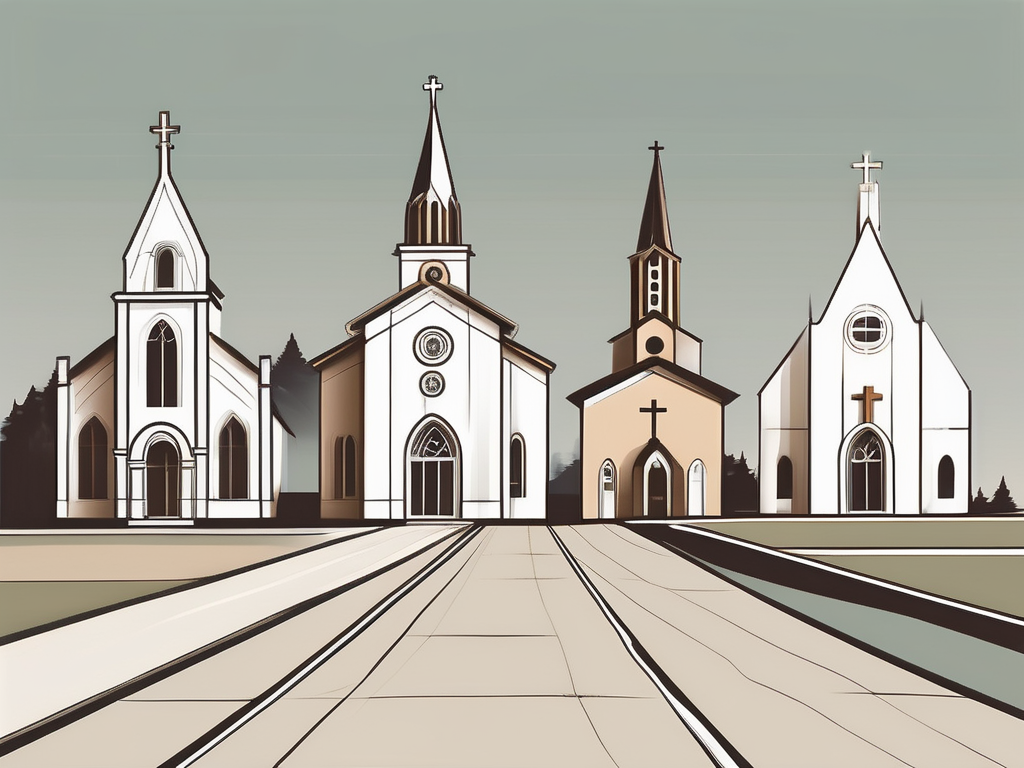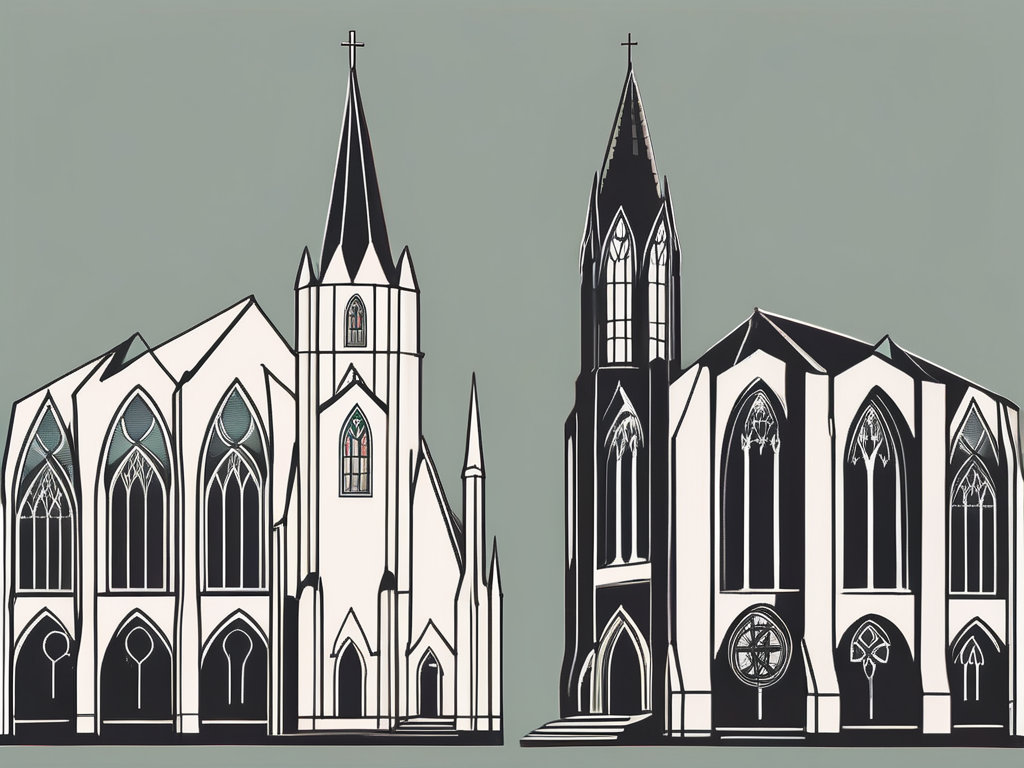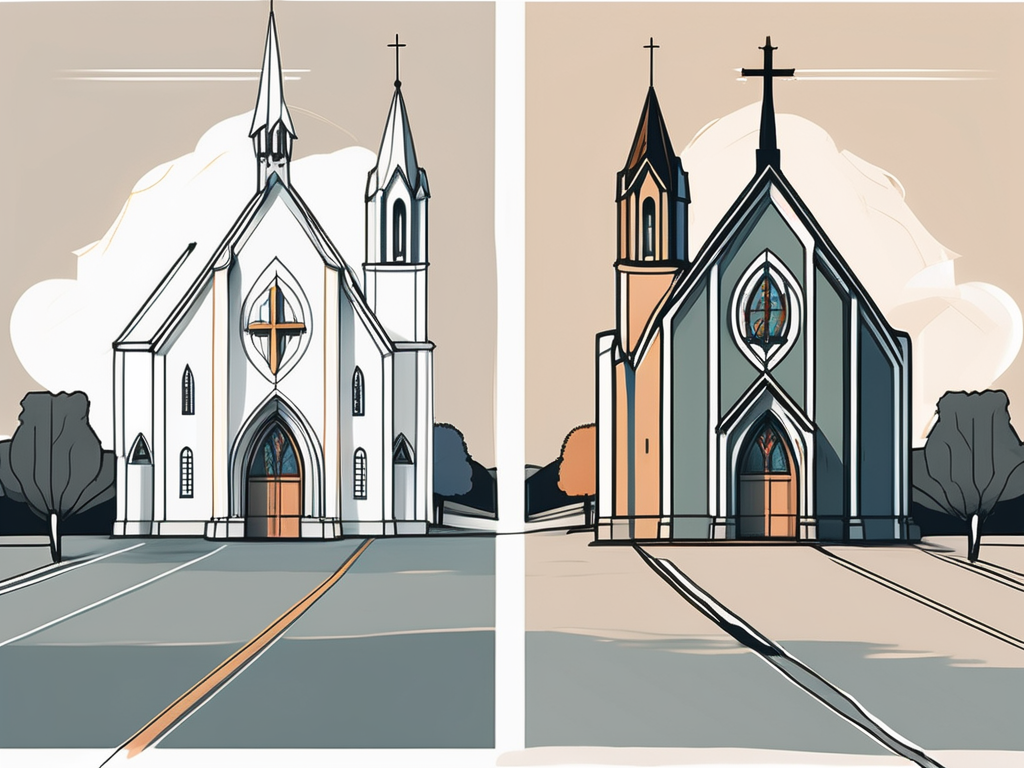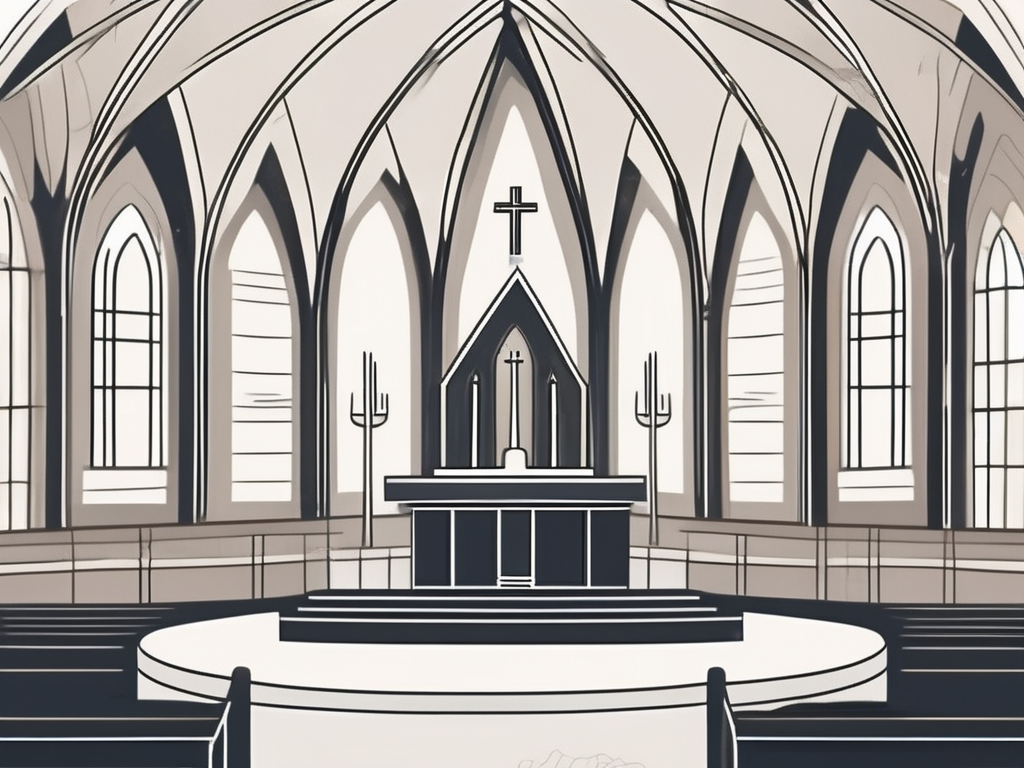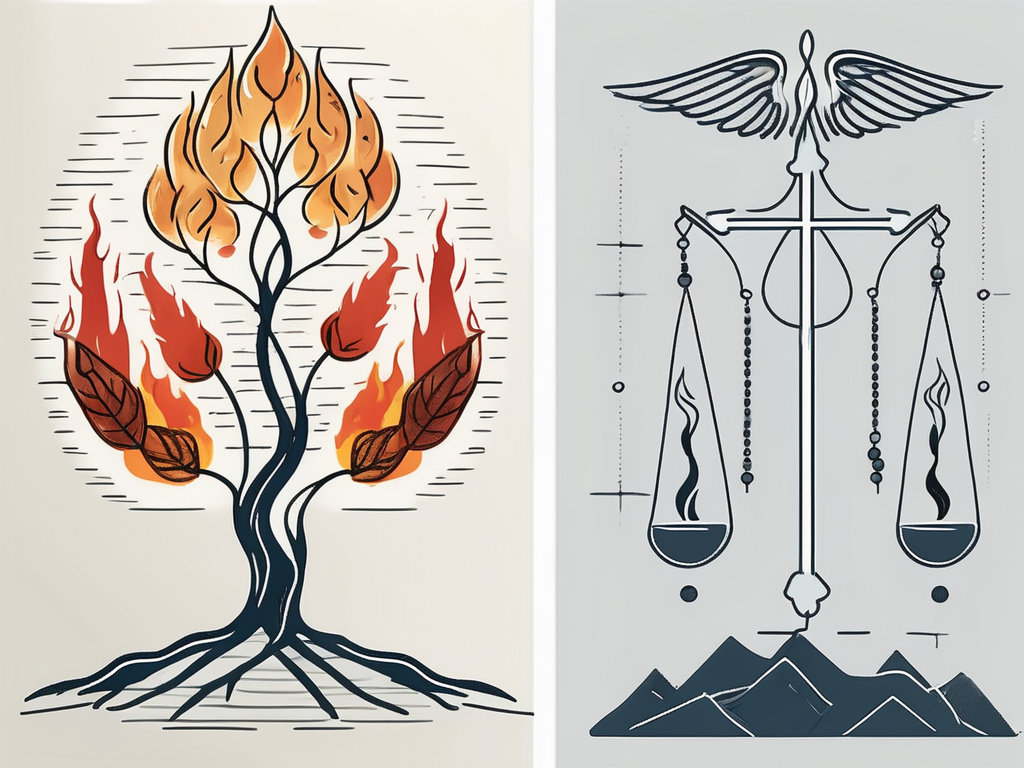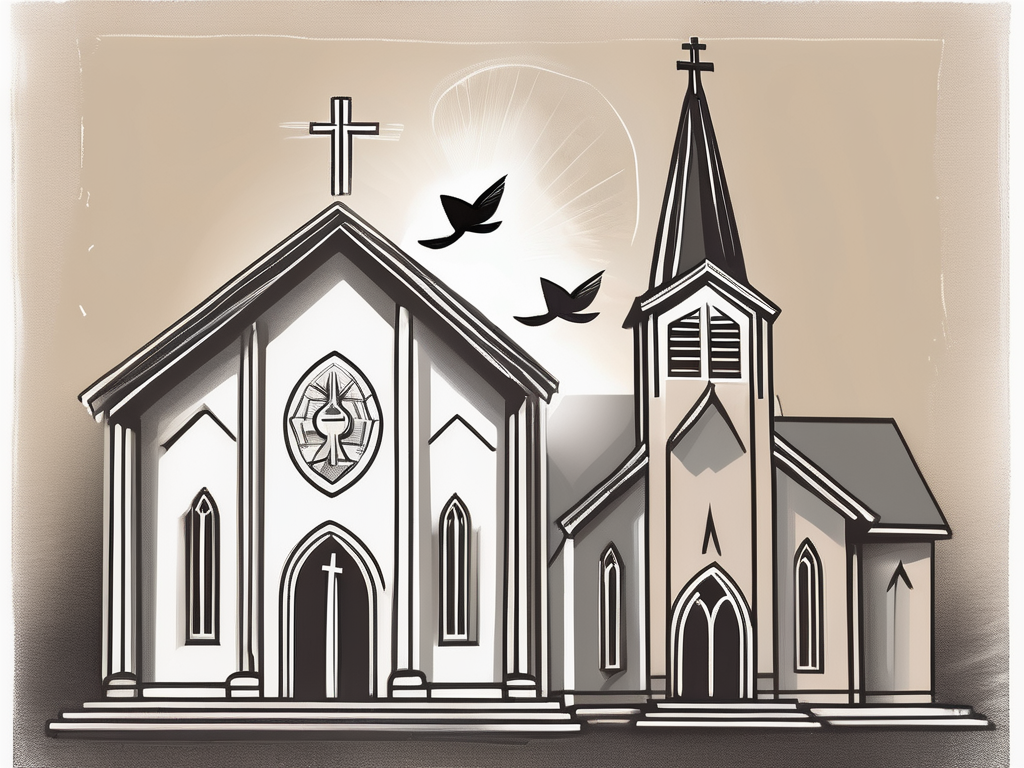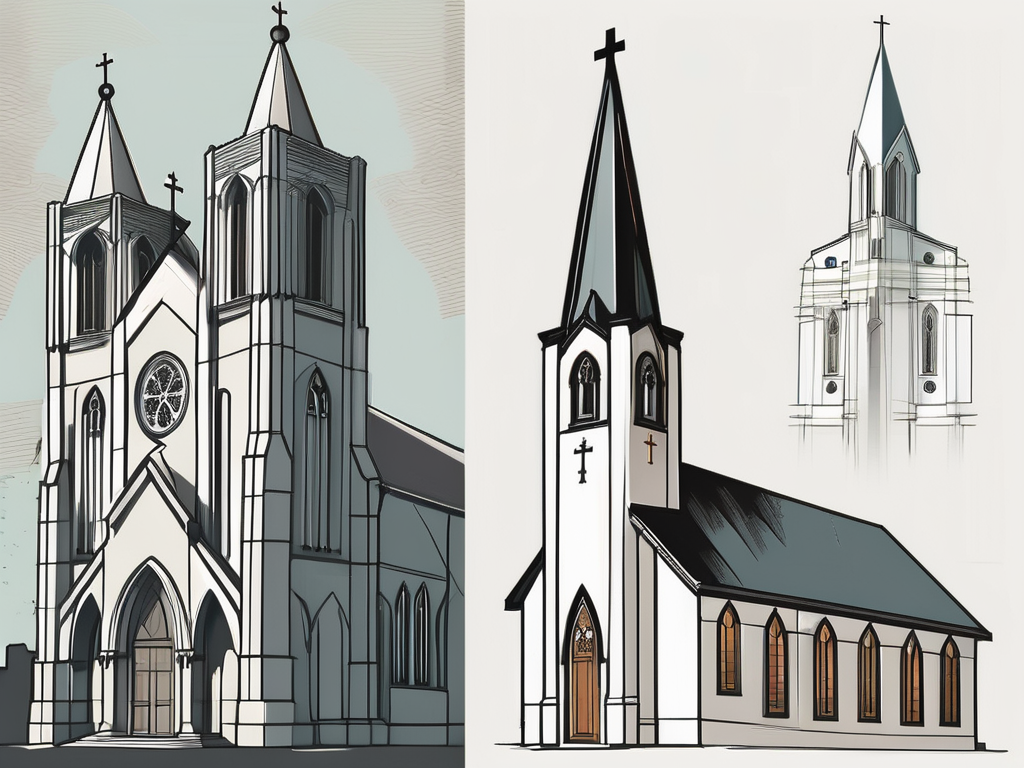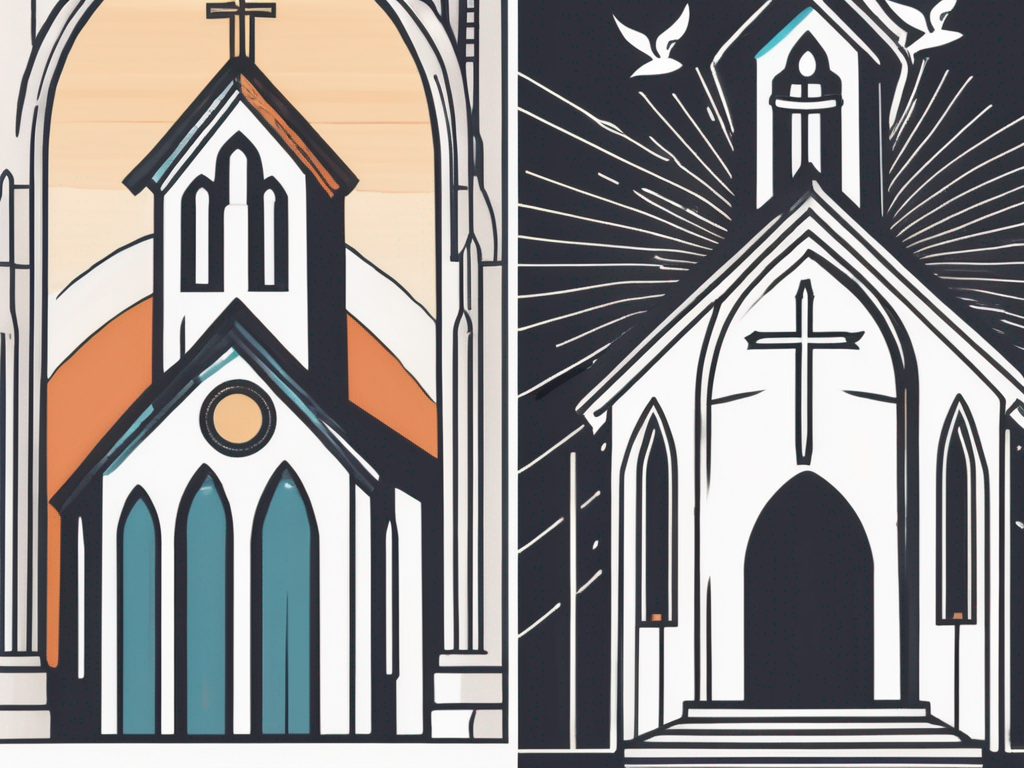When it comes to matters of faith, there are various denominations and belief systems that shape our religious landscape. Presbyterianism and Catholicism are two such denominations that have left an indelible mark on Christianity. In this article, we will delve into their similarities and differences, exploring their history, key beliefs, organizational structures, and societal impact.
Understanding the Basics of Presbyterianism
Presbyterianism, with its roots stemming from the Protestant Reformation, holds a significant place in Christian history. It emerged in the 16th century in Scotland and later spread to other parts of Europe, including North America.
Central to Presbyterian doctrine is the belief in the sovereignty of God. Presbyterians emphasize the authority of the Bible and view it as the inspired Word of God. They believe in the doctrine of justification by faith alone and salvation through Christ’s sacrifice.
The Origin and History of Presbyterianism
The roots of Presbyterianism can be traced back to the teachings of John Knox, a prominent figure in the Scottish Reformation. Knox’s efforts to reform the Church of Scotland led to the establishment of a Presbyterian system of church governance, characterized by the rule of presbyters or elders.
Presbyterianism gained momentum in Scotland, becoming the established church in the 17th century. It played a significant role in shaping Scottish society and culture, influencing not only religious practices but also political and educational institutions.
With the migration of Scottish and Irish Presbyterians to North America in the 18th and 19th centuries, Presbyterianism took root in the United States. The Presbyterian Church in the United States of America (PCUSA) was formed in 1789, and it remains one of the largest Presbyterian denominations in the country.
Key Beliefs and Practices of Presbyterians
Besides the emphasis on the sovereignty of God, Presbyterians place great importance on the communal nature of worship and the role of ordained ministers. They believe in the sacraments of baptism and the Lord’s Supper (also known as communion) as essential acts of faith.
Presbyterians have a strong tradition of congregational singing, often accompanied by pipe organs or other musical instruments. Hymnody holds a special place in Presbyterian worship, with many churches having a rich repertoire of hymns that reflect their theological beliefs and heritage.
Furthermore, Presbyterians value education and intellectual engagement. Historically, they have established numerous colleges and seminaries to train ministers and promote scholarship within the denomination. Education is seen as a means to deepen one’s understanding of the faith and equip individuals to serve their communities.
Presbyterians also hold a strong commitment to social justice, and many actively engage in charitable endeavors and advocacy for the marginalized and oppressed. The belief in the inherent dignity and worth of every individual drives their efforts to address systemic injustices and promote equality.
Organizational Structure of the Presbyterian Church
The Presbyterian Church functions based on a system of governance known as presbyterian polity. This system is characterized by the rule of presbyteries, consisting of elected elders who oversee the spiritual welfare of the church.
At the national level, the Presbyterian Church is organized into synods and general assemblies that provide oversight and guidance to local presbyteries. This hierarchical structure balances the authority between the clergy and laity within the church.
Presbyterian churches often have committees and boards dedicated to specific areas of ministry, such as missions, education, and social justice. These bodies work collaboratively to coordinate and support the work of the church, ensuring that its mission is carried out effectively.
Presbyterians also have a strong tradition of democratic decision-making within the church. Important matters are typically discussed and voted upon by the congregation, with decisions made collectively and guided by the principles of fairness and inclusivity.
In conclusion, Presbyterianism is a rich and diverse tradition within Christianity, with a history that spans centuries and continents. Its emphasis on the sovereignty of God, communal worship, social justice, and democratic governance continue to shape the beliefs and practices of Presbyterians around the world.
Delving into Catholicism
Catholicism, one of the oldest Christian denominations, traces its roots back to the time of Jesus Christ and his apostles. It developed as the dominant form of Christianity in the Western Roman Empire and continues to be a major force in the world today.
Catholics believe in the authority of the Pope as the successor of St. Peter, whom they consider the first bishop of Rome. They hold a sacramental worldview, emphasizing the importance of rituals and the role of the Church in matters of salvation.
The Origin and History of Catholicism
Catholicism originated from the teachings of Jesus Christ, who entrusted his apostles with the responsibility of spreading his message. The early Christian communities, under the leadership of the apostles, formed the foundation of what would later become the Catholic Church.
As the message of Jesus spread, the Catholic Church faced numerous challenges and underwent significant transformations. In the early centuries, it had to contend with persecution from the Roman Empire, which saw Christianity as a threat to its authority. However, despite the hardships, the Church continued to grow and gain followers.
One of the pivotal moments in Catholic history was the conversion of Emperor Constantine to Christianity in the 4th century. This event not only ended the persecution of Christians but also elevated the status of the Church. With the support of the state, the Catholic Church became a powerful institution, influencing both religious and political affairs.
Throughout the Middle Ages, the Catholic Church played a central role in European society. It was not only a religious authority but also a political force, with the Pope exercising significant influence over monarchs and kingdoms. The Church’s power and wealth grew, leading to the construction of magnificent cathedrals and the establishment of monastic orders.
Key Beliefs and Practices of Catholics
Catholics hold doctrines such as the Holy Trinity, the divinity of Christ, and the resurrection. These core beliefs form the foundation of Catholic theology and shape the way Catholics understand their faith.
In addition to these fundamental beliefs, Catholics also place great importance on the seven sacraments. These sacraments are seen as visible signs of God’s grace and are considered essential for the spiritual journey of a Catholic. Baptism, the first sacrament, is seen as the gateway to the Christian life, while the Eucharist, or Holy Communion, is the central sacrament in which Catholics believe they receive the body and blood of Christ.
Participation in the Mass, the central liturgical celebration of the Catholic Church, is considered an essential aspect of a Catholic’s spiritual life. The Mass is a time for worship, reflection, and communion with God and the community. It involves prayers, readings from the Bible, the Eucharistic celebration, and the sharing of peace.
Adherents of Catholicism also honor the Virgin Mary and the saints. They believe that Mary, as the mother of Jesus, holds a special place in salvation history and serves as a model of faith. The saints, on the other hand, are seen as holy men and women who have lived exemplary lives and are now in the presence of God. Catholics seek their intercession and guidance in their journey of faith.
Organizational Structure of the Catholic Church
The Catholic Church operates under a hierarchical structure known as the episcopal polity. At the apex of this hierarchy is the Pope, who serves as the spiritual leader of Catholics worldwide.
Below the Pope are bishops, who oversee dioceses, which are further divided into parishes. Bishops are responsible for the pastoral care and governance of their respective dioceses, ensuring that Catholic teachings and practices are followed and upheld.
Within the dioceses, priests are assigned to individual parishes, where they provide spiritual guidance and administer the sacraments to the faithful. They play a vital role in the day-to-day life of Catholics, offering pastoral care, celebrating Mass, and providing counseling and support.
This hierarchical structure ensures the unity and consistency of Catholic teachings and practices across different regions. It allows for a centralized authority that can address theological questions, make decisions on matters of faith and morals, and provide guidance to the faithful.
Comparing Presbyterian and Catholic Beliefs
While Presbyterianism and Catholicism share common roots in Christianity, there are significant differences in their beliefs and practices. Let’s explore some of these variations.
Similarities in Doctrine and Practice
Both denominations affirm the divinity of Jesus Christ, the importance of Scripture, and the practice of baptism. They also embrace the concept of a loving and merciful God, stressing the significance of prayer and worship in the life of believers.
Additionally, Presbyterians and Catholics express a commitment to social justice and philanthropy, seeking to alleviate suffering and promote the common good in their respective communities.
Presbyterians, influenced by the teachings of John Calvin, emphasize the sovereignty of God and the belief in predestination. They believe that God has predetermined the eternal destiny of every individual, whether it be salvation or damnation. This doctrine of predestination is a distinctive feature of Presbyterian theology.
Catholics, on the other hand, place a strong emphasis on the authority of the Pope and the hierarchical structure of the Church. They believe that the Pope, as the successor of Saint Peter, has the authority to interpret Scripture and make infallible pronouncements on matters of faith and morals.
Both denominations value the importance of community and fellowship. Presbyterians gather in congregations led by elected elders, while Catholics come together in parishes led by priests. In both cases, these leaders provide spiritual guidance and pastoral care to their respective communities.
Differences in Doctrine and Practice
While Presbyterians emphasize the authority of the Bible, Catholics integrate Tradition as a source of revelation alongside Scripture. Catholicism also upholds the teachings of the Magisterium, which interprets Scripture and Tradition, while Presbyterians rely more on individual interpretation.
The sacraments hold divergent roles in the two denominations. Catholics consider them as channels of grace, essential for salvation, while Presbyterians view them primarily as symbols of faith and acts of obedience.
In the Catholic Church, there are seven sacraments: baptism, confirmation, Eucharist, reconciliation, anointing of the sick, holy orders, and matrimony. Each sacrament is believed to confer a specific grace and is administered by a priest or bishop. Presbyterians, on the other hand, only recognize two sacraments: baptism and the Lord’s Supper (also known as communion or the Eucharist).
Another significant difference lies in the understanding of the role of Mary, the mother of Jesus. Catholics venerate Mary and believe in her immaculate conception and assumption into heaven. They see her as a powerful intercessor and pray to her for her guidance and protection. Presbyterians, while acknowledging Mary’s importance, do not hold these same beliefs and practices regarding her.
Furthermore, the structure of worship services differs between the two denominations. Catholic Mass is highly ritualized, with a set liturgy and specific prayers and responses. Presbyterian worship services, on the other hand, tend to be more flexible and can vary from congregation to congregation.
It is important to note that these are just a few of the many differences and similarities between Presbyterianism and Catholicism. The rich history and diverse theological perspectives within Christianity continue to shape and influence these denominations and their beliefs.
Comparing Presbyterian and Catholic Church Structures
In addition to theological differences, Presbyterianism and Catholicism exhibit contrasting organizational structures, shaping how the church operates and makes decisions.
Similarities in Church Governance
Both denominations embrace a form of representative church governance. In Catholicism, authority and decision-making are vested in the Pope, the College of Cardinals, and bishops. Presbyterian churches, on the other hand, operate on a system of elected elders who share the responsibility of leading the congregation.
Both systems aim to balance the role of clergy and laypeople, reflecting a shared belief in the priesthood of all believers.
Differences in Church Governance
Catholicism’s hierarchical structure concentrates significant authority in the Pope, who holds supreme jurisdiction over matters of faith and morals. Presbyterianism, in contrast, distributes power more evenly among elected elders at the local, regional, and national levels.
The differing structures influence the decision-making processes and adaptability of each denomination to societal changes.
Societal Impact and Influence: Presbyterianism vs Catholicism
Religious denominations often play a significant role in shaping society and impacting the lives of individuals. Both Presbyterianism and Catholicism leave indelible footprints in their communities, albeit in different ways.
Role and Influence in Society: Presbyterian Perspective
Presbyterianism, with its strong emphasis on social justice, has historically championed causes such as civil rights, education reform, and poverty alleviation. Many Presbyterian churches actively engage in community-building initiatives, advocating for equality and making efforts to address systemic injustices.
Presbyterians believe in the importance of education and have established numerous schools and colleges, contributing to the intellectual and moral development of individuals and communities.
Role and Influence in Society: Catholic Perspective
Catholicism, as one of the largest religious denominations in the world, wields considerable influence across various spheres of society. The Catholic Church operates extensive networks of schools, hospitals, and charitable organizations, providing essential services and support to diverse populations.
Catholics also have a rich tradition of art, music, and literature, which have enriched cultural heritage and continue to inspire creativity and imagination.
In conclusion, Presbyterianism and Catholicism, despite their theological differences, share common threads that bind them to their Christian heritage. Understanding these denominations’ distinctive beliefs, practices, and structures helps foster a spirit of appreciation and dialogue among different faith traditions. As we navigate the complex religious landscape, may we seek to find common ground and celebrate the richness of diversity within the broader Christian family.



